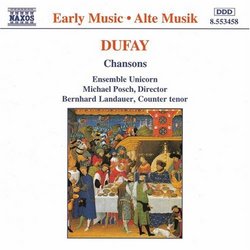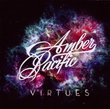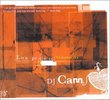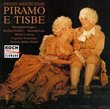| All Artists: Guillaume Dufay, Antonio Vivaldi, Michael Posch, Michel Posch, Bernhard Landauer, Ensemble Unicorn Title: Dufay: Chansons Members Wishing: 1 Total Copies: 0 Label: Naxos Release Date: 5/21/1996 Genres: Special Interest, Pop, Classical Styles: Vocal Pop, Opera & Classical Vocal, Forms & Genres, Ballads, Concertos, Rondos, Historical Periods, Baroque (c.1600-1750) Number of Discs: 1 SwapaCD Credits: 1 UPC: 730099445825 |
Search - Guillaume Dufay, Antonio Vivaldi, Michael Posch :: Dufay: Chansons
 | Guillaume Dufay, Antonio Vivaldi, Michael Posch Dufay: Chansons Genres: Special Interest, Pop, Classical
|
Larger Image |
CD DetailsSimilar CDs
|
CD ReviewsLovely J. P. Johnson | Ewing, NJ United States | 12/28/2000 (5 out of 5 stars) "This lovely CD contains 9 instrumental pieces and 8 sung pieces, almost evenly alternating. That balance and variety seems to me one of the best features of the disc. The liner notes are good and I enjoyed reading the brief biographies of the members of Ensemble Unicorn. For the chansons I was pleased to be given both the original French text and an accompanying English translation. The recording was done in Evangelische Kirche A.B., Vienna, and the acoustics there complement Dufay's compositions very well. If all that you know of Dufay are his masses, then this CD is an excellent next addition. But even if you are not familiar with Dufay, you will enjoy this broadly appealing disc." The Unicorn Ensemble "get medieval" on Dufay Eddie Konczal | 02/17/2006 (4 out of 5 stars) "The Unicorn Ensemble's collection of Guillaume Dufay's "Chansons" is a fine recording, with excellent performances using period instruments that vividly evoke the spirit of the Middle Ages. My main reservation about "Chansons" is that it might give you the wrong impression about Dufay, one of the most forward-looking composers of the 15th century. The Unicorn Ensemble's instrumental textures are a joy to listen to, but they tend to obscure Dufay's polyphonic innovations. To be sure, Dufay's greatest advances came in the realm of sacred music, with his chansons largely governed by the "formes fixes" that held sway over early Renaissance secular music. But the ingenious Dufay found ways to bend the rigid song structures to his will. Take 'Se la face ay pale' for example, a through-composed chanson in which Dufay employs voice crossings and close imitation to achieve a sophisticated polyphonic tapestry. The Unicorn Ensemble performs this chanson instrumentally (as they do with about half the songs in this collection). Their interpretation is textured and inspired, but obscures the effect of Dufay's polyphony. Another chanson performed instrumentally is "Resveilliés vous et faites chiere lye," written for the 1423 wedding of Carlo Malatesta and Vittoria Colonna. In its original version, Dufay highlighted the groom's name with a homophonic treatment of the line "Charle, gentil." Without voices, the effect is lost. The overall effect of "Chansons" is to cast Dufay's music as essentially Medieval; many of these arrangements wouldn't sound out of place on Unicorn Ensemble's "Codex Faenza," featuring music written by composers who lived a century before Dufay. Dufay's secular music is undoubtedly rooted in medieval sensibilities, but his approach to vocal polyphony classes him as early Renaissance. Fans of Medieval instrumental music will treasure "Chansons," and rightly so. But those interested in the music of Dufay should also seek out one of his Masses, such as "Missa L'homme arme" (also on Naxos) or (if you can find it) "Missa Se la face ay pale" (based on the chanson found here). One should hear Dufay's music as vocal polyphony to truly experience the glorious achievements of this early Renaissance master." Good, very good for a budget release Eddie Konczal | 09/16/1998 (4 out of 5 stars) "It is difficult to fault Naxos when they produce full-price quality recordings like this CD at less than half the price of other labels. The young Austrian counter tenor Bernhard Landauer gives polished performances of 8 Dufay chansons, and the five members of Unicorn add variety to the program by preceding each chanson with lively instrumental pieces. 62'37" playing time, useful notes and full texts and translations. A bargain."
|

 Track Listings (17) - Disc #1
Track Listings (17) - Disc #1


